Benefits and Applications of Polycarbonate Panels
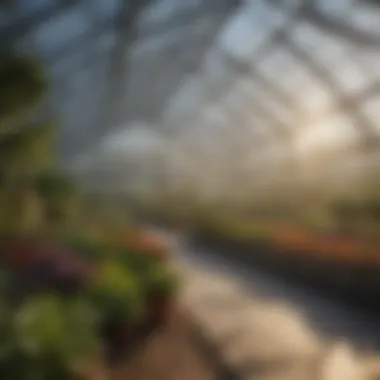

Topic Overview
Definition and Importance
Polycarbonate panels are a unique construction material known for their durability and versatility. They are made from a thermoplastic polymer, which is engineered to be exceptionally strong yet lightweight. These panels have become vital in various sectors, particularly in agriculture and horticulture. In farming, they serve as protective barriers that allow sunlight to penetrate while shielding crops from harsh weather and pests. Their significance lies not only in their functional properties but also in their ability to enhance productivity and sustainability in agricultural practices.
Brief History and Evolution
The journey of polycarbonate began in the mid-20th century. Initially, it was developed for industrial applications due to its remarkable resistance to impact and temperature. Over the years, farmers and growers recognized its potential in agricultural settings. By the late 1980s, its usage in greenhouses started gaining popularity, leading to more innovations in production techniques and applications. Today, polycarbonate panels are not just viewed as a material; they have evolved into an essential component that supports advanced agricultural methods, including precision farming and microclimate control.
Key Techniques and Innovations
Sustainable Farming Practices
With the global shift towards sustainability, polycarbonate panels play a crucial role. They help in minimizing energy consumption as they can efficiently insulate while allowing adequate light transmission. This feature supports the growth of plants while reducing the need for excessive heating or cooling. Farmers can utilize these panels to create eco-friendly structures that promote organic practices. Additionally, they are resistant to UV degradation, ensuring longevity and lesser replacement costs, which provides economic advantages alongside environmental benefits.
Advanced Agronomic Technologies
The integration of polycarbonate panels with advanced technologies has transformed agricultural capabilities. For instance, smart greenhouses equipped with sensors and automated systems manage light, humidity, and temperature more effectively. Coupled with polycarbonate's insulating properties, these technologies create ideal growing environments, leading to higher yields.
Some of the advancements include:
- Climate-controlled greenhouses that optimize growing conditions.
- Integrated Pest Management systems that use panels to create barriers against pests while allowing airflow.
- Hydroponic farming systems that utilize efficiency-driven designs with polycarbonate covers for water conservation and improved nutrient management.
Practical Applications
Step-by-Step Guides
If you're considering implementing polycarbonate panels in your farm, several steps can guide you. Here’s a straightforward approach:
- Determine the Purpose: Understand what you want to achieve - is it crop protection, energy efficiency, or aesthetic appeal?
- Select the Right Panel: Choose between multi-wall or solid panels based on your application. Multi-wall panels are excellent for insulation, while solid panels are typically more durable.
- Design the Structure: Draft a plan for your greenhouse or structure, ensuring to account for ventilation and access.
- Installation: Depending on your skill level, either do it yourself following manufacturer guidelines or hire a professional.
- Maintenance Practices: Regularly check for any structural damage and clean the panels to maintain light transmittance.
Case Studies or Real-World Examples
A notable case is the adoption of polycarbonate panels in the Netherlands, a country known for its extensive greenhouse farming. Dutch farms utilize these panels extensively for their greenhouses, enhancing crop yields while managing energy costs effectively. Here, robust panels have proven their worth against the country's variable climate, reinforcing the idea that with the right materials, farming can be both productive and sustainable.
"The use of polycarbonate panels has revolutionized our ability to grow fresh produce, even in the colder months. It has not only improved my yields but also reduced costs significantly."
— A Dutch greenhouse farmer.
Preamble to Polycarbonate Panels
Polycarbonate panels are increasingly becoming a go-to solution in the world of agriculture and horticulture, capturing attention not just for their durability but for their adaptability. Understanding the significance of these panels is key for farmers and agricultural enthusiasts alike, as it enables them to harness the full potential of this innovative material.
Polycarbonate panels offer a blend of properties that make them suitable for a variety of applications. From acting as protective coverings in greenhouses to serving as essential components in agricultural structures, their versatility shines. Moreover, the importance of the panels can’t be understated in today’s rapid-paced agricultural technology landscape. Farmers who are attuned to advancements and make informed choices will find themselves at a competitive edge.
Definition and Composition
To grasp the potentials of polycarbonate panels, one must first understand what they are. Polycarbonate is a robust thermoplastic material, created through a process that involves polymerizing bisphenol A (BPA) and phosgene. This unique composition gives polycarbonate its characteristic strength and resilience, making it almost unbreakable compared to glass, while still maintaining a lightweight profile.
The panels themselves come in various forms—aesthetic clear or tinted designs, corrugated styles, or flat sheets—catering to a diverse range of preferences and needs. The ingenuity of polycarbonate lies in its transparency; it allows for a remarkable amount of light transmission, making it a favorite in horticultural applications. The fact that it can easily be shaped into different sizes for specific requirements adds another feather to its cap.
History and Development
Tracing back to the late 1950s, polycarbonate was first introduced as a synthetic material. Initially, its use revolved around the manufacturing of compact discs and eyewear due to its optical clarity and strength. Over the decades, its application spread like wildfire, findig its way into numerous sectors, including construction, automotive, and of course, agriculture.
The development of polycarbonate panels read like a tale of innovation. With increasing demand for energy efficiency and sustainable practices, agricultural experts began exploring how these panels could be used in greenhouses. The ability to create controlled climates while ensuring protection against harsh weather conditions set the stage for broader adoption. Additionally, as environmental considerations grew in importance, the panels were tailored to meet these new demands, leading to enhancements in heat retention and UV protection. Each step in the evolution of polycarbonate demonstrates a responsive technology adapting to the needs of its users, especially in the agricultural domain, where the stakes are particularly high.
Material Properties of Polycarbonate
Understanding the material properties of polycarbonate panels is crucial for anyone looking to integrate them into agricultural practices. These properties not only define the performance of the panels under various environmental conditions but also influence the long-term value they can provide to farmers. When good weather turns bad, or pests start to swarm, knowing the ins and outs of polycarbonate characteristics can make all the difference.
Durability and Impact Resistance
One of the standout features of polycarbonate panels is their exceptional durability. Made from a robust thermoplastic material, polycarbonate is far tougher than glass, and it boasts an impressive resistance to impact. This resilience means that polycarbonate can withstand the force of hailstorms, heavy winds, and even the accidental bump from farm equipment. Farmers can rest easy knowing that their investments won’t shatter easily when Mother Nature throws a tantrum.
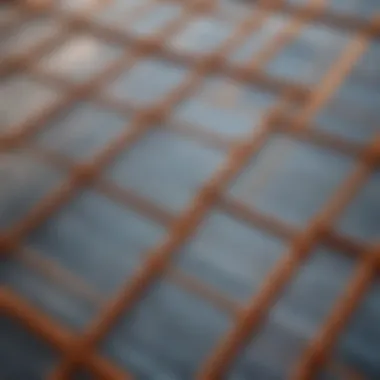
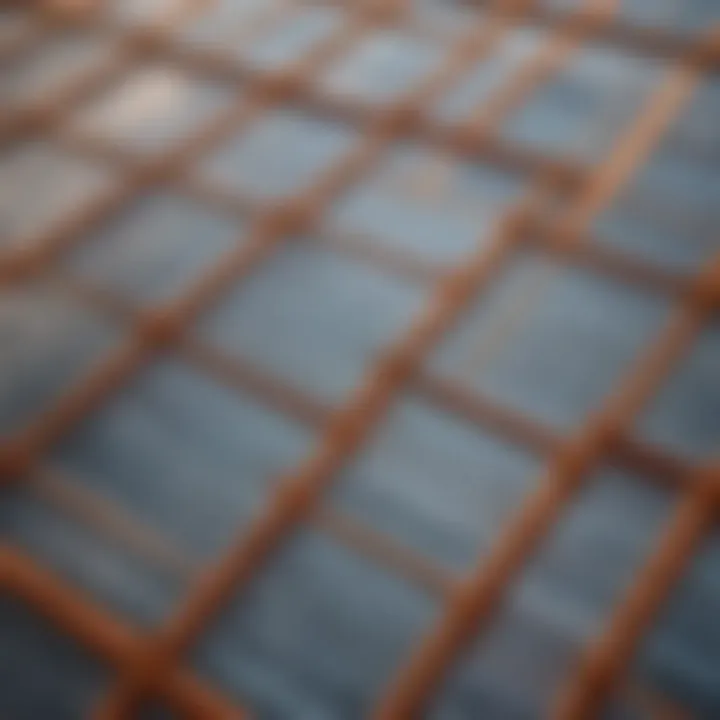
In practical terms, the impact resistance of polycarbonate panels has real implications. For instance, in regions prone to severe weather—think the Midwest during tornado season—the use of these sturdy panels in greenhouses can safeguard crops where traditional glass might break easily. Imagine the peace of mind knowing your livelihood is better protected as storms roll through.
"Polycarbonate panels offer unparalleled impact protection, ensuring longevity and security for agricultural structures."
Light Transmission and UV Protection
Another essential property of polycarbonate is its ability to transmit light while providing UV protection. Polycarbonate can allow up to 90% of natural light to permeate, making it a favorite choice for greenhouses where plants flourish under abundant sunlight. However, unlike clear glass, polycarbonate panels have the added benefit of blocking harmful UV rays. This means that while crops can soak in the sunlight they crave, they're protected from potential UV damage that can stunt growth or degrade quality.
Having the right balance of transmission and UV protection is vital for maximizing crop yield. For instance, crops such as tomatoes and cucumbers thrive with the right lighting. Farmers often report that polycarbonate’s light quality leads to faster growth rates compared to traditional materials. This efficiency can translate into higher produce quality and ultimately, a more profitable harvest.
Thermal Insulation Characteristics
When the temperature outside fluctuates, polycarbonate panels help maintain a stable environment inside greenhouses. Their thermal insulation properties are noteworthy, as they can keep warmer air inside during chillier months while reflecting excess heat in the summer. This dynamic ability allows for more controlled growing conditions, reducing the need for additional heating or cooling systems.
The insulation qualities of polycarbonate can be particularly useful in regions with extreme temperature variations. Farmers who use these panels may find that they can extend their growing season while minimizing energy costs. More optimal growing conditions lead to healthier plants and a longer window for harvest, thus amplifying agricultural productivity.
In summary, the material properties of polycarbonate panels—durability, light transmission, and thermal insulation—cultivate a landscape where agricultural practices can thrive. By tapping into these advantages, farmers are equipped to make informed decisions that would ultimately enhance sustainability and profitability.
Advantages of Using Polycarbonate Panels
Understanding the advantages of polycarbonate panels provides essential insights into their role within the agricultural sector. These panels are not just functional; they bring with them a suite of benefits that can impact both the efficiency of agricultural practices and the bottom line of farmers. With their unique properties, polycarbonate panels stand out as a worthy investment in any agricultural setting.
Cost-Effectiveness Over Time
One of the primary considerations for farmers is cost. Polycarbonate panels, despite a higher initial outlay compared to traditional materials, tend to save money over time. The durability of these panels means fewer replacements and repairs are needed. Unlike glass, which can shatter under pressure, polycarbonate is almost unbreakable. This resilience translates to long-term savings in materials and labor. Additionally, their insulating properties help reduce energy consumption, particularly for climate-controlled environments such as greenhouses.
"Investing in polycarbonate panels can lead to significant savings—not just in repairs, but on energy bills, too."
Economically, the longevity of polycarbonate contributes to reducing overall expenditure on agricultural infrastructure. With a variety of styles and thicknesses available, farmers can choose panels that best suit their specific budgets and goals, ensuring that their investments are aligned with their operational needs.
Resistance to Environmental Conditions
Another standout factor is the polycarbonate's exceptional ability to withstand harsh environmental conditions. Whether facing the sweltering heat of summer or the biting chill of winter, these panels hold their ground. They are built to resist ultraviolet light without degrading, crucial for maintaining the integrity of the crops beneath. For farmers seeking to protect their produce from the elements, this resistance is invaluable.
Moreover, polycarbonate panels can endure hail and strong winds, which would otherwise compromise traditional glass structures. This durability not only protects crops but also minimizes damage to the infrastructure itself. Farmers can cultivate a peace of mind, knowing that their investment is shielded from the whims of nature.
Versatility in Design and Application
Polycarbonate panels are not one-size-fits-all. They come in various shapes, sizes, and thicknesses, making them incredibly versatile for different applications in agriculture. Whether it's a greenhouse, aquaculture system, or any other agricultural need, the adaptability of polycarbonate panels allows for innovation in design.
These panels can be easily molded and shaped to fit specific architectural needs. This flexibility means farmers can construct systems that maximize light entry and enhance plant growth while ensuring conditions are tailored to specific crops.
In addition, the ease of installation plays a significant role. Unlike heavier materials, polycarbonate is lightweight, which means that setup is less labor-intensive and can often be completed in less time. This efficiency allows farmers to focus on what truly matters—their crops.
In summary, polycarbonate panels offer a blend of cost efficiency, resilience against environmental factors, and design flexibility that is hard to match. Exploring these advantages helps farmers make informed decisions about their agricultural investments, ultimately contributing to more successful farming practices.
Applications in Agriculture
The role of polycarbonate panels in agriculture cannot be overstated. These materials offer a unique blend of durability, insulation, and light transmission, which are essential for optimal crop growth and stability in varying environmental conditions. Understanding how they integrate into agricultural practices can help farmers harness these benefits effectively.
Greenhouses and Crop Protection
Polycarbonate panels are particularly prominent in the construction of greenhouses. By using these panels, agriculturists can create a controlled environment where temperature and humidity levels are optimal for growing plants. Unlike traditional glass, polycarbonate is much lighter and more durable, reducing the risk of breakage from hail or impacts.
One key feature is the two-fold light transmission capability. It can filter UV rays while allowing enough sunlight to penetrate, promoting photosynthesis without damaging the crops. As a result, plants grow healthier and can even produce yields that exceed those grown without protective coverings.
Moreover, polycarbonate greenhouses usually require less heating compared to glass due to their insulating properties. This not only translates into lower energy costs but also a consistent temperature for crops. Ultimately, this leads to higher efficiency and lower operational costs, making polycarbonate a wise investment for farmers seeking sustainability.
Aquaculture and Animal Housing
Aquaculture is another arena benefiting from polycarbonate use. Clear panels are used in tanks and other structures to create optimal conditions for fish and aquatic plants. The transparency allows for easy monitoring of aquatic life, making it simpler to assess health and growth patterns. Polycarbonate's resistance to chemicals and corrosion also makes it suitable for long-term exposure to water and various aquatic environments.
In terms of animal housing, polycarbonate can be utilized to create insulated shelters that protect livestock from harsh weather conditions. These panels maintain an even internal temperature and allow adequate lighting, which helps in keeping the animals comfortable. When housed properly, livestock tend to exhibit better health and productivity.
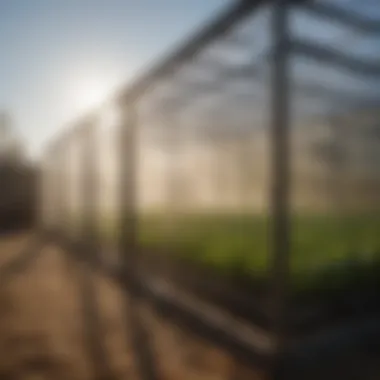
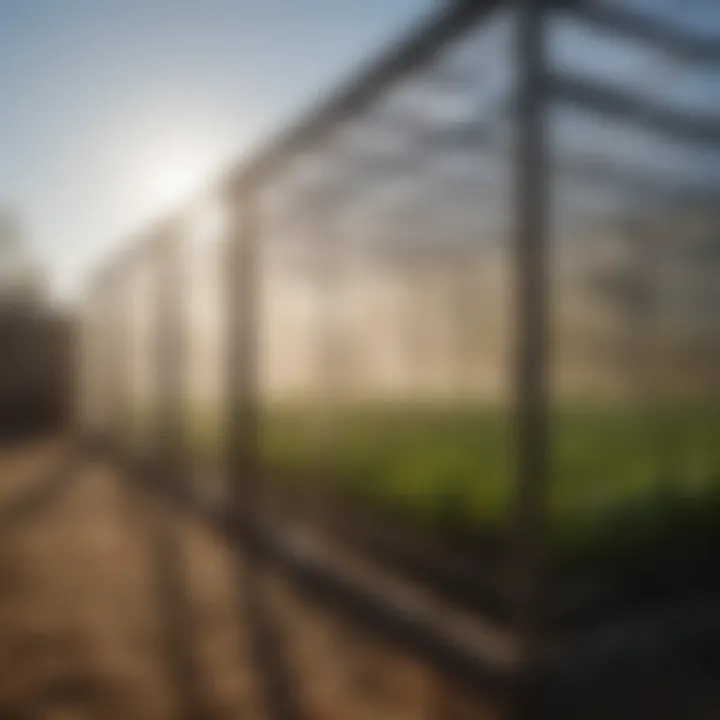
Sustainable Energy Solutions
Sustainable energy solutions are increasingly becoming a necessity in agriculture. Polycarbonate panels can be integrated with solar technologies to form energy-efficient structures. The ability to allow light to pass through while generating energy makes them an ideal choice for farms looking to invest in renewable energy.
Using solar panels in conjunction with polycarbonate materials can boost energy production while still maintaining the light levels essential for crop growth. This dual-use approach not only provides electricity but also reduces dependency on non-renewable energy sources.
"Polycarbonate panels represent a significant step toward integrating technology and traditional farming practices, offering both resilience and sustainability."
In summary, the applications of polycarbonate panels in agriculture extend far beyond mere protective coverings. Their flexibility in design, durability, and energy efficiency opens up possibilities for innovative agricultural practices that can ultimately lead to increased yields and reduced environmental impact.
Installation and Maintenance
The proper installation and ongoing maintenance of polycarbonate panels are pivotal for maximizing their functionality and lifespan. Given the investment involved, it’s essential to ensure that these panels are installed correctly and cared for over time. This section dives into essential practices that can improve the performance of polycarbonate installations in agricultural settings and highlights tips for keeping them in peak condition.
Installation Best Practices
When setting up polycarbonate panels, there are a few guidelines that should be followed to guarantee a successful installation.
- Choose the Right Type of Panel: Different agricultural structures may require specific types of polycarbonate panels due to variations in thickness, profile, and UV protection levels. Take the time to select the panel that aligns with the needs of your operation.
- Ensure Proper Framing: Good framing is crucial to support the panels adequately. The frame should be robust enough to withstand wind loads and should allow for expansion and contraction of the polycarbonate material.
- Follow Manufacturer Instructions: Every brand has distinct guidelines for installation. Adhering to these instructions ensures that the panels will perform as intended and be covered by warranty.
- Sealing and Fastening: Use compatible fasteners and sealing materials that won’t react with polycarbonate. Ensure that the panels are securely fastened at the edges to eliminate gaps that can lead to leaks.
- Think About Orientation: Orientation can dramatically affect performance regarding light transmission and heat retention. Adjust the angle based on the specific crops or livestock involved, optimizing for the needs at play.
Proper installation not only enhances efficiency but also prevents potential issues like leaking, which can damage crops and lead to significant losses.
Maintenance Tips for Longevity
Maintaining polycarbonate panels might seem tedious, but it pays off significantly. Here are some actionable tips:
- Regular Cleaning: Dust, dirt, and residues can accumulate on panels, reducing their efficiency. Clean with a gentle soap solution and soft cloth to avoid scratching the surface.
- Inspect for Damage: Regular checks for chips, cracks, or other damages can help catch problems before they escalate. Any compromised section should be repaired or replaced quickly to ensure continued functionality.
- Check Fasteners and Seals: Over time, seals may weaken, and fasteners can corrode. Inspect them periodically to maintain a secure structure.
- Avoid Harsh Chemicals: Using harsh chemicals may degrade the panel's material integrity. Stick to gentle cleaning agents to keep the panels in good condition.
- Temperature Awareness: During extreme temperature changes, the polycarbonate can expand and contract. It’s wise to observe how your installation stands up during seasonal changes.
Following these guidelines will ensure that your polycarbonate panels continue to perform effectively for many seasons to come, thereby supporting the productivity of your agricultural practices.
Environmental Impact and Sustainability
As we wade through the complexities of modern agriculture, it’s critical to acknowledge the footprint our practices leave behind. Polycarbonate panels, while often viewed through the lens of utility and design, also play a significant role in our environmental strategies. Understanding their sustainability and overall impact not only informs best practices but also guides us towards more responsible choices in agriculture. This section delves into two significant aspects: recyclability of polycarbonate materials and energy efficiency related to their use.
Recyclability of Polycarbonate Materials
Polycarbonate panels are not just durable; they are also recyclable. This feature is essential for those who are keen on minimizing their waste output. Unlike some plastics which end up in landfills, polycarbonate can often be repurposed or recycled into new products, extending its life cycle beyond initial usage.
When looking at recycling, it’s worth noting:
- Conducive Systems: Many local recycling facilities have the capability to handle polycarbonate materials. This makes it easier to divert waste from landfills.
- Grade Variation: Not all polycarbonate is created equal. The grade of the material can affect its recyclability, influencing what and how much can be recycled.
- Handling Processes: Proper handling during the disposal process is crucial, as contaminated materials may not be accepted for recycling.
Investing in these recyclable materials can mean supporting a more circular economy, where end-of-life products are transformed instead of discarded. This aligns with sustainable farming practices, which not only regard the immediate benefits but also long-term environmental health.
Energy Efficiency in Agriculture
Energy efficiency is another notable benefit of utilizing polycarbonate panels, especially in agricultural settings. In regions where heating is a necessity, the thermal insulating capabilities of these panels can significantly lower energy consumption. This not only bolsters the eco-friendliness of agricultural practices but also provides economic relief for farmers.
Here are some key points regarding energy efficiency:
- Insulating Properties: Polycarbonate panels exhibit superior insulation compared to traditional glass, limiting heat loss in colder months and maintaining cooler temperatures during warmer spells.
- Light Diffusion: They allow light to penetrate while diffusing it evenly. This quality reduces the need for artificial lighting, helping farmers save on energy costs.
- Adaptable Designs: Whether used in greenhouses or barn roofs, these panels can be designed to maximize sunlight exposure and minimize energy use based on specific regional climates.
Thus, the integration of polycarbonate panels in agricultural structures not only enhances productivity but also aligns with broader sustainability goals.
"Adopting polycarbonate is not just about improving infrastructure; it’s a step towards a greener future."
In summary, recognizing the recyclability of polycarbonate materials along with their energy efficiency illustrates how these panels contribute positively to both the agricultural and environmental landscape. With ongoing advancements and sustained awareness, the agriculture sector can continue to evolve into a more sustainable sphere.
Challenges and Limitations
Understanding the challenges and limitations of polycarbonate panels is crucial for anyone considering their use in agriculture. While these panels boast numerous advantages, recognizing their drawbacks ensures that farmers and enthusiasts can make informed decisions. Addressing potential vulnerabilities in the materials and being aware of cost-related issues plays a significant role in optimizing the benefits these panels offer. The following subsections delve deeper into specific challenges that come with using polycarbonate panels.
Vulnerability to Chemical Damage
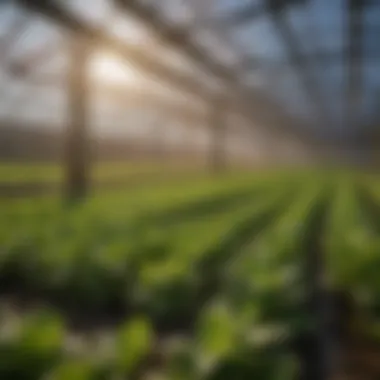
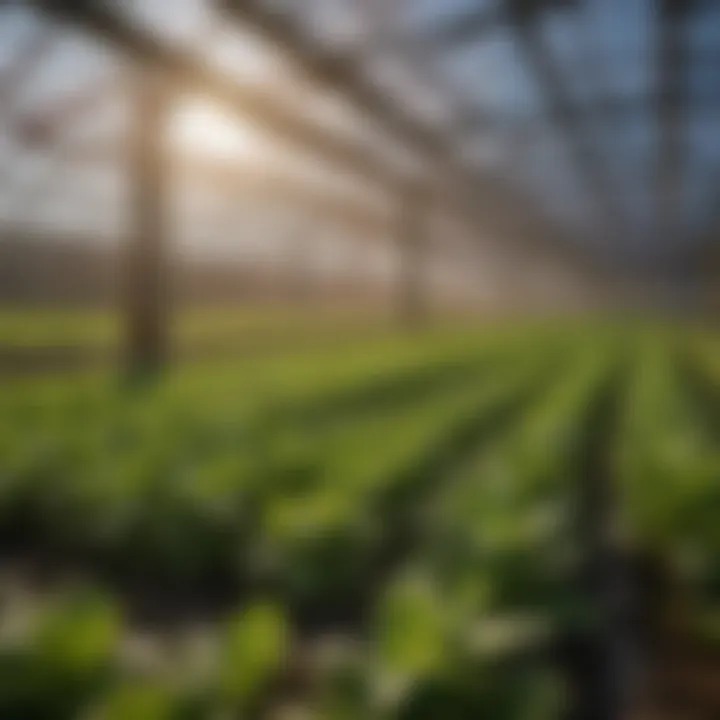
Polycarbonate is a robust material, yet its resistance to chemicals leaves something to be desired. Various agricultural substances, such as certain pesticides and herbicides, can degrade polycarbonate panels over time. This vulnerability can lead to cracking, discoloration, or eventual panel failure if not monitored closely. When selecting polycarbonate, one must consider the specific chemicals used in their operations. It’s generally advisable to check compatibility before committing to any particular type.
Here are a few key points to keep in mind regarding chemical interactions:
- Identify Common Chemicals: Farmers must know the chemicals that they frequently use and verify their effects on polycarbonate materials.
- Protective Measures: Implementing protective measures, such as installing a protective coating, can be beneficial. However, it's essential to balance the cost of these protective layers with the gains.
- Regular Inspections: Periodic checks can help in identifying early signs of damage due to chemical exposure, ultimately extending the life of the panels.
"Prevention is better than cure." Keeping an eye on the health of polycarbonate panels can save you both time and money in the long run.
Cost Variability and Accessibility
Another significant challenge revolves around the cost and accessibility of polycarbonate panels. Their pricing can fluctuate widely due to various factors, including production costs, quality, and market demand. This variability can make budgeting for operations difficult, particularly for small-scale farmers.
Moreover, accessibility may vary based on geographical location. While some regions might have an abundance of suppliers, others could face challenges in sourcing high-quality polycarbonate panels. This inconsistency can lead to:
- Budgeting Issues: Disparities in pricing make it hard to predict costs reliably.
- Supply Chain Delays: Waiting for shipments can hinder timely installation and operation, leading to missed opportunities in production.
- Quality Control: Not all manufacturers adhere to the same standards, meaning that farmers might end up with subpar products if they're not careful.
Farmers should approach their procurement strategy with a mindful perspective, shopping around for the best balance between cost and quality. Understanding the local market dynamics is also pivotal in making informed purchasing decisions.
Innovations in Polycarbonate Technology
The evolution of polycarbonate technology is leading to significant improvements in its application, especially in agriculture. Understanding these innovations is critical for farmers and enthusiasts, as they navigate the ever-changing landscape of agricultural materials. The advancements not only enhance performance but also address the needs for sustainability and efficiency in farming practices. Keeping updated with these trends can help in optimizing grow environments, ultimately resulting in more productive agricultural operations.
Advancements in Coating Techniques
The development of advanced coating techniques for polycarbonate panels stands as a testament to modern innovation. Coatings serve several purposes: improving scratch resistance, enhancing UV stabilization, and even imparting antimicrobial properties. These enhancements maximize the lifespan of polycarbonate played a key role in efficiency—for example, anti-fog coatings allow for better visibility and light transmission in greenhouses, promoting healthier plant growth.
While selecting a coating, farmers should consider factors such as durability and the environment in which the panels will be used. Selecting a panel with appropriate coatings can mitigate common issues, such as clouding from weather exposure or biological growth that can block light.
"Choosing the right coating can make a world of difference in outcomes when working with polycarbonate panels in agriculture."
Here are some examples of common coatings used:
- Anti-scratch coatings: Increase durability and lower maintenance needs
- UV protective layers: Shield plants from harmful radiation
- Anti-fog application: Maintains visibility under varying conditions
Thus, the choice of coatings not only impacts panel longevity but also efficiency in growing conditions.
Smart Panel Technologies
In the realm of technology, smart panels represent the next frontier in polycarbonate applications. These panels integrate sensors and smart technology to monitor and regulate the internal environment of greenhouses or other agricultural structures. What this means for farmers is a more controlled environment that can adapt in real-time to the needs of crops.
Imagine a polycarbonate panel that can adjust its thermal insulation capabilities based on the weather outside. With smart technology, this becomes possible; these panels can help to manage temperature fluctuations, improving energy efficiency. Smart panels can also monitor humidity levels and even send alerts to farmers when conditions deviate from optimal parameters.
Some potential benefits of smart panel technologies include:
- Enhanced thermal management: Lower energy costs and better crop health
- Real-time data monitoring: Informed decision-making through insights gained from live data
- Automation potential: Reduced manual engagement needed for monitoring and control
By investing in smart panel technologies, farmers may find it easier to achieve optimal growth conditions for various crops, leading to improved yields and resource savings.
Each advancement in polycarbonate technology—whether it be coating techniques or smart panel systems—steers the field towards sustainable practices and greater efficiency. As these technologies continue to develop, they promise both immediate benefits and long-term implications for the future of agriculture.
End
The conclusion serves as a vital summation of the discussions we've had throughout the article. It reflects not only the benefits and attributes of polycarbonate panels, but also contextualizes their applications within the agricultural sphere.
Summary of Key Insights
To recap, polycarbonate panels are renowned for their durability and high impact resistance, making them a smart choice for various agricultural applications, including greenhouses and livestock habitats. Their remarkable light transmission abilities, combined with effective UV protection, enable optimal conditions for plant growth while safeguarding crops from harmful rays. Economically, these panels offer a cost-effective solution over time, enhancing their appeal for farmers looking to balance quality with budgetary constraints.
Not to overlook, the installation and maintenance practices discussed highlight how proper handling of these materials can prolong their lifespan. Additionally, recognizing the environmental impacts offers a richer understanding of sustainable farming practices.
"Incorporating polycarbonate panels can transform agricultural efficiency and sustainability."
This leads us to a versatile conclusion, cementing the importance of considering these panels within the larger picture of agricultural innovation. Understanding their properties, advantages, and limitations ensures better decisions that align with both economic and environmental goals.
Future Outlook
Looking ahead, the future of polycarbonate technology seems promising. Increased innovations in coating techniques and the emergence of smart panel technologies are likely to enhance functionality even more. Imagine panels that could self-regulate temperature or adapt to varying light levels; the agricultural possibilities are compelling.
Moreover, as awareness grows about eco-friendly practices, the demand for sustainable materials in agriculture is expected to rise. Polycarbonate panels, with their recyclability and energy efficiency, are well-positioned to meet these needs. Farmers and professionals who embrace these shifts will not only elevate their practices but also contribute positively to the environment.



